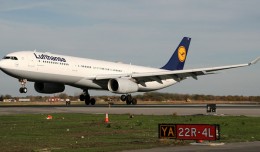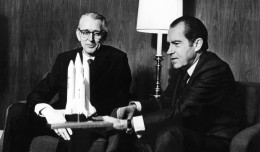2012 – The captain of a JetBlue flight from New York to Las Vegas suffers a nervous breakdown mid-flight, forcing a diversion to Amarillo, Texas. No one is injured.
1999 – A Soviet anti-aircraft missile takes down an F-117 Nighthawk in the Kosovo War for the first and only time thus far in its career.
1994 – The Eurofighter Typhoon, a twin-engine fighter designed by Alenia Aeronautica, BAE Systems and EADS, makes its maiden flight.
1990 – An Angolan Government CASA C-212 Aviocar 300 is shot down near Kuito, Angola by UNITA forces, killing all 25 on-board.
1990 – An Uzbek Civil Aviation Administration Ilyushin IL-76D (CCCP-78781) stalls on final approach to Kabul and crashes. All 11 aboard are killed.
1984 – British Airways begins flights from London to Miami on the Concorde twice a week. With a stop for fuel at Washington Dulles Airport, the 6 hour, 35 minute flight saves 2 1/2 hours versus conventional aircraft.
1977 – The Tenerife Disaster, the deadliest plane crash in history, takes place on a foggy day at Tenerife North Airport (then known as Los Rodeos Airport). Several aircraft, including a KLM Boeing 747-200 (PH-BUF) and Pan Am Boeing 747-100 (N736PA “Clipper Victor”), divert to Tenerife because of a bombing at their original destination, Las Palmas Airport in Gran Canaria, Spain. Tenerife, being a small airport with only one runway and taxiway, requires that the 5 or so diversions park on the taxiway, and then back-taxi and turn around on the runway when it came time to depart. The KLM aircraft taxied into takeoff position while the Pan Am taxied down the runway from the other end, but they are not visible due to each other due to the very dense fog. The KLM Captain either misunderstands ATC or decides on his own, commences takeoff. Only in the final moments do they realize they are on a collision course. The Pan Am attempts to vacate the runway unsuccessfully as the KLM rotates early, dragging its tail, but the belly of the KLM 747 rips into the main cabin and its right engines go right through the upper deck of the Pan Am aircraft. The KLM continues almost a quarter-mile before bursting into flames with its full fuel tanks. All 248 aboard the KLM aircraft perish and there are only 61 survivors among the 335 Pan Am occupants…a total death toll of 583.
1969 – Mariner 7, one of two robotic probes sent to inspect Mars’ atmosphere and ice caps, launches.
1962 – A Cubana de Aviacion Ilyushin IL-14 (CU-T819) crashes into the sea about a mile from Santiago, Cuba, killing all 22 aboard.
1951 – A Douglas Dakota DC-3, being operated by Air Transport Charter crashes shortly after takeoff from Runway Airport in Manchester, England. Ice forms on the carburetor after the Captain fails to properly use the heat controls, making the engines unable to gain enough power to climb. Of the 6 aboard, 4 die.
1931 – TWA Flight 599, a Fokker F-10 (NC-999) crashes in Chase County, Kansas, killing all 8 aboard. The wood laminate construction of the aircraft became weak over time until a wing spar failed and separated from the aircraft. This brought upon the very first every grounding of an aircraft type.
1927 – Airmail pilot Charles A. Lindbergh registers for a contest offering a $25,000 prize to fly across the Atlantic solo.







